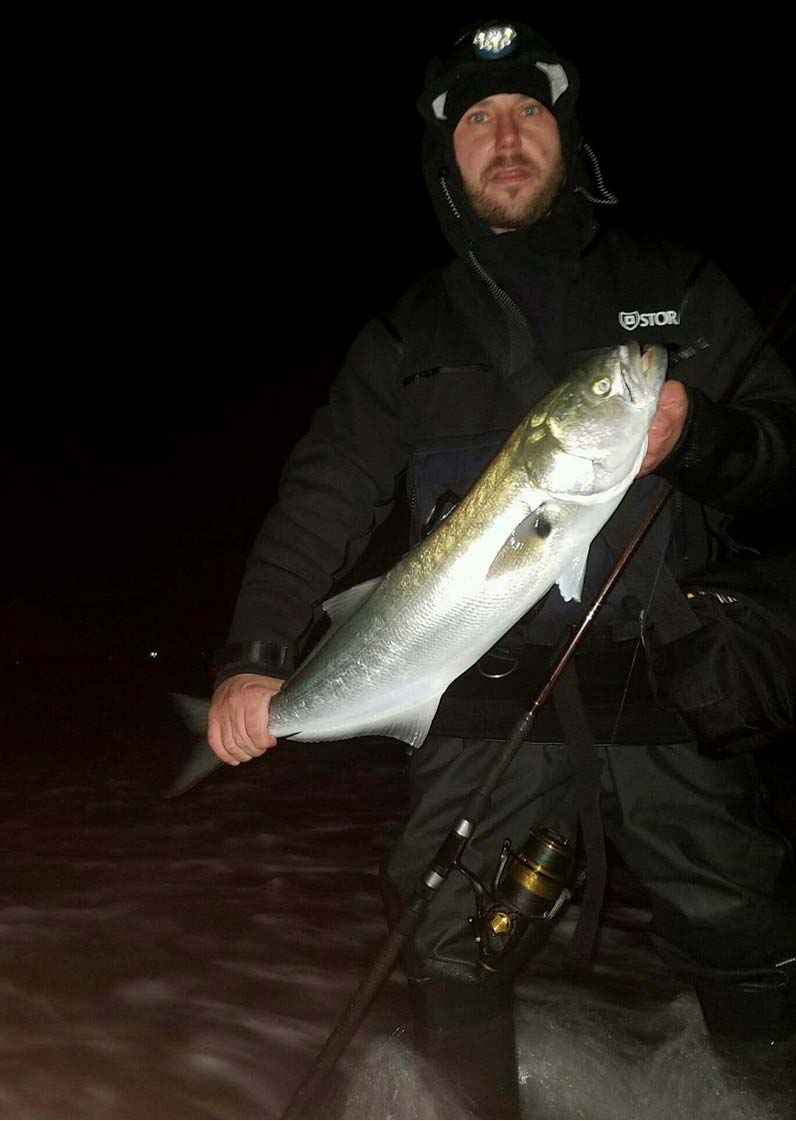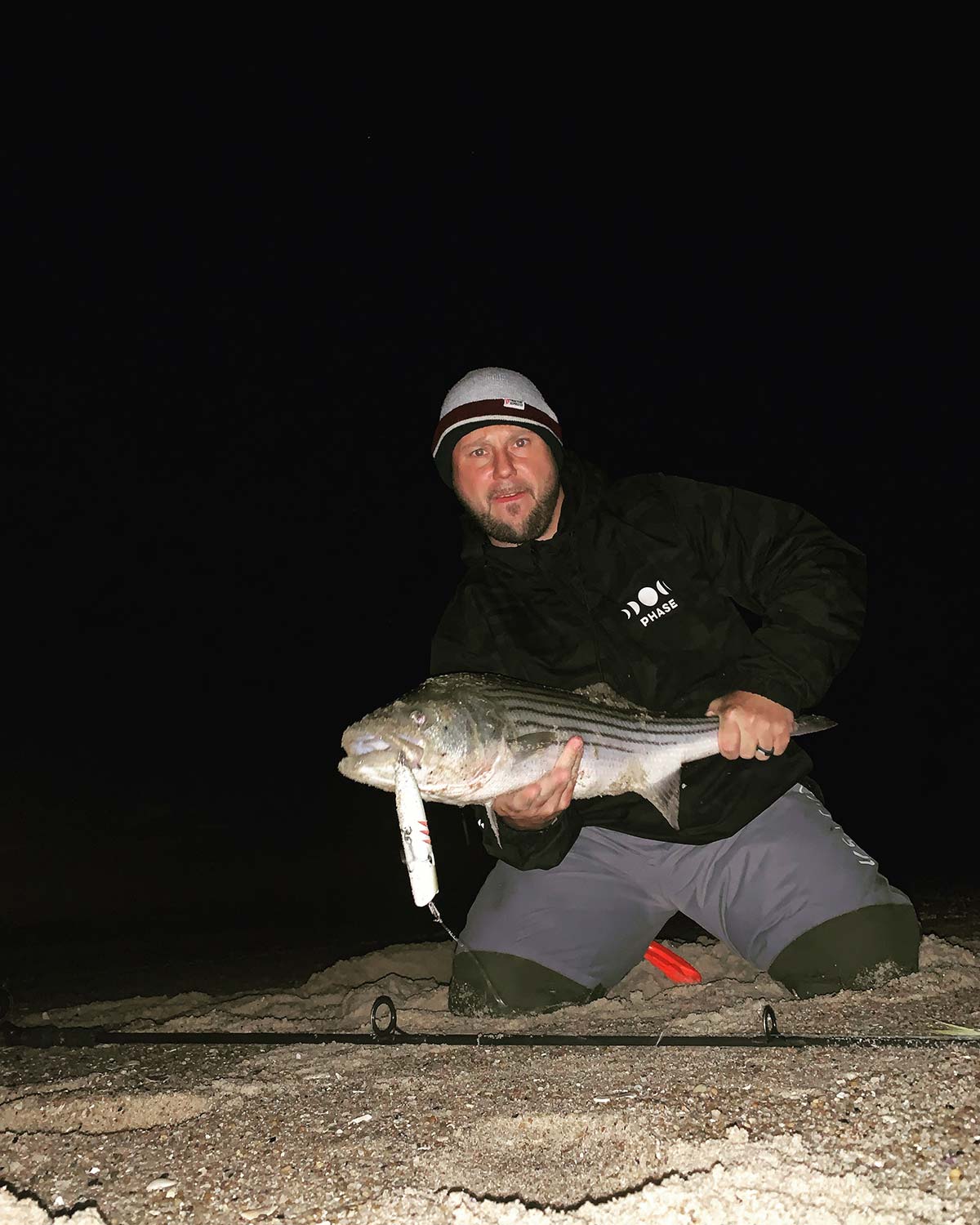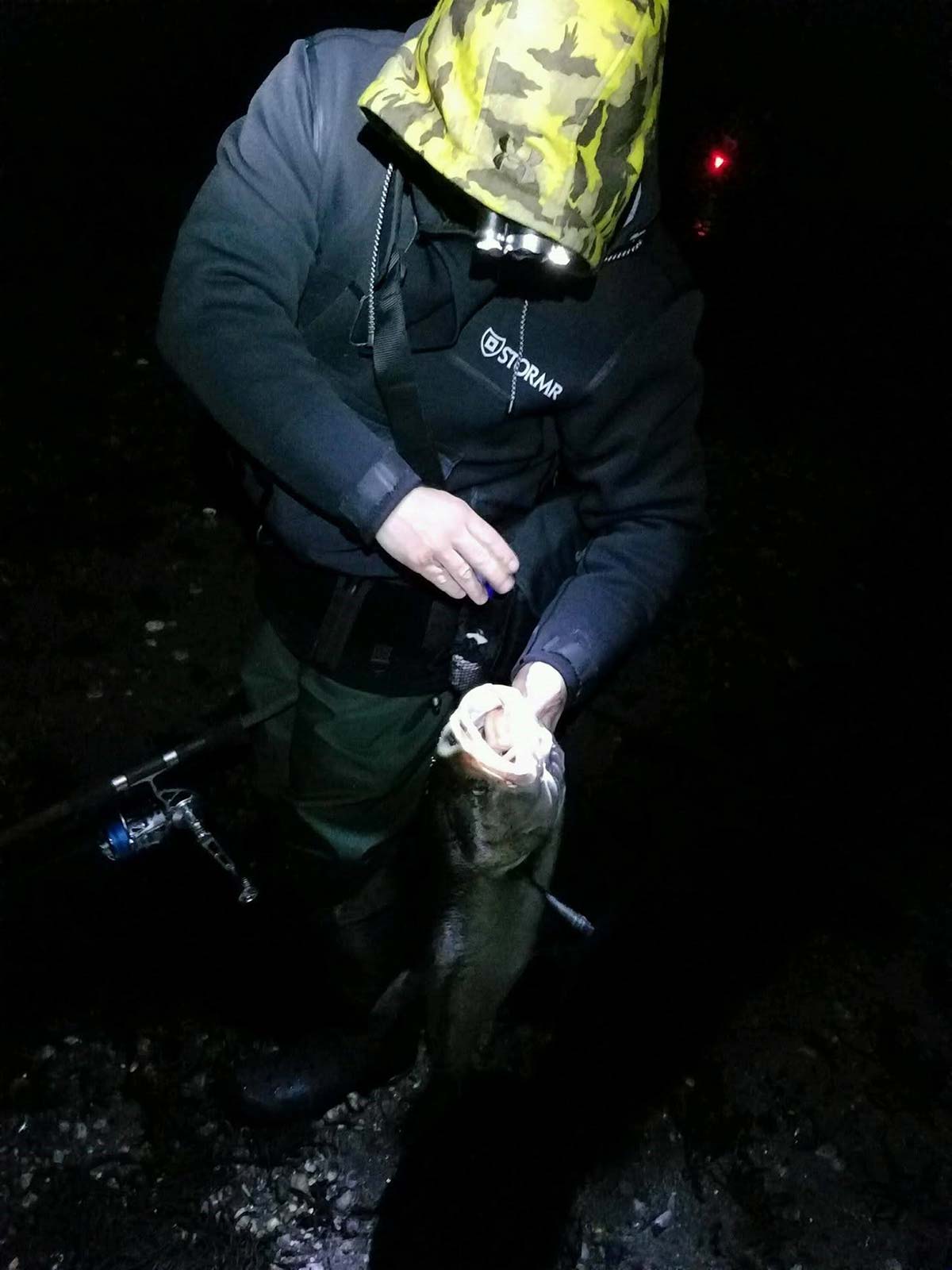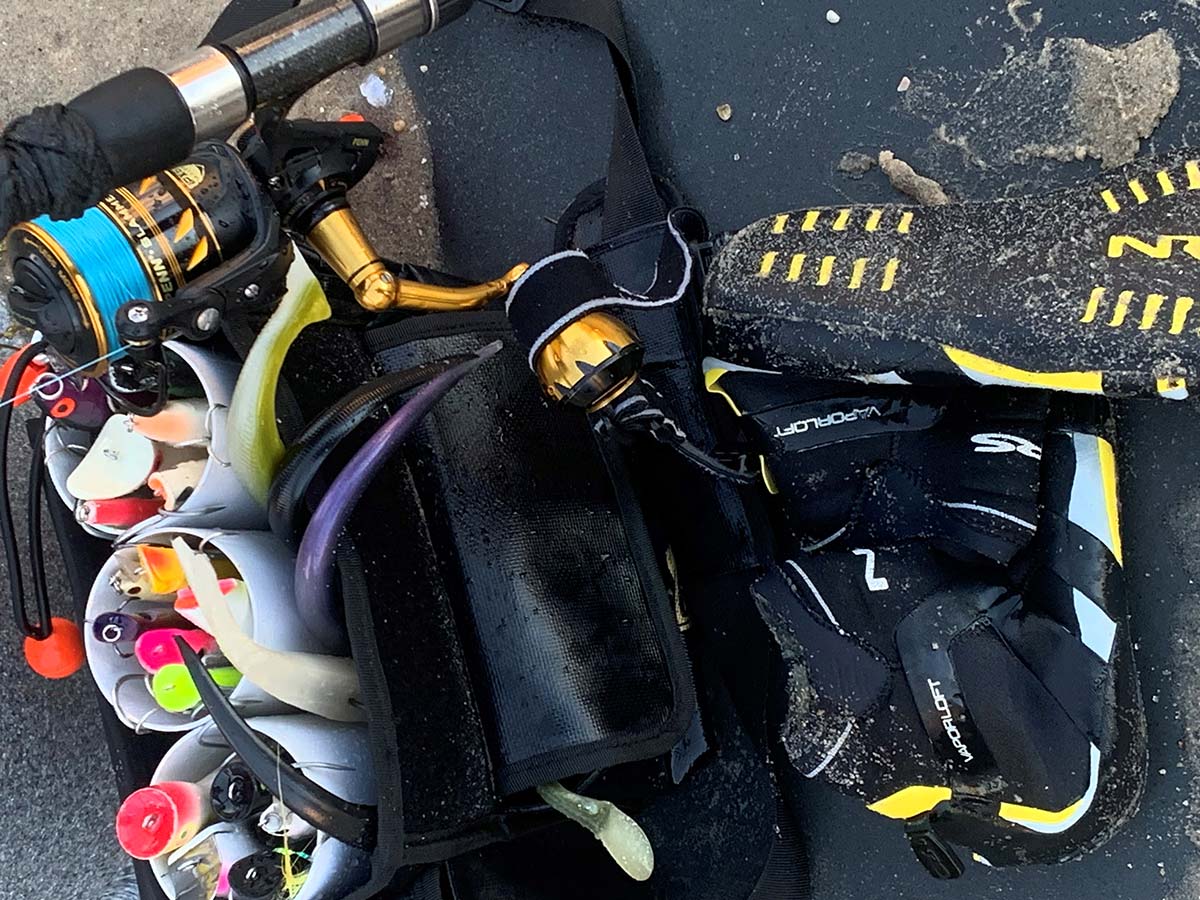
Lengthen your surf season by gearing up properly.
Fall, September 22nd to December 22nd, as defined by our seasonal calendar, most anglers I fish with, whether it be Jersey or up in Groton, usually start dropping off around the second or third week of October. I guess a cup of hot cocoa and Netflix sounds more appealing than numb, frozen hands, cold feet, and a screaming drag — well, not for me. There’s usually only about a 45-day break in my season between January and February, so I need all the help staying warm in the water as I can get without comprising mobility. According to my wife, I’m a psychopath. If you ask me, I just like fishing, but I’m sure the truth lies closer to her description.
Surf fishing in the late fall into early winter can be an intimidating and daunting task to some, as well as miserable and fruitless if you aren’t prepared mentally and gear-wise, but it doesn’t have to be.
Stay Warm And Mobile
Let’s start with the most important part of late fall surf fishing: keeping warm and staying dry. My go-to during the colder months is usually an Under Armor base layer, top and bottom — thin, light, and warm with flexibility. Depending on the temperature and what I’m wearing over everything to keep me dry, I may add another regular long-sleeve waffle-style thermal top. Next is a fleece-lined sweatsuit top and bottom, something that stretches well and is not too tight. Now I throw on a pair of thick, warm socks and pull them over the sweat pant cuffs for when I don my waders so they don’t pull up. Sometimes, I put a thin pair of ankle socks over those. Over all of that, I pull on my nylon stocking foot waders.
I rarely wear wading boots and opt for a minimum of a five-mill flats boot or wetsuit boots. Cressi or Evo are two favorites of mine. There are many companies that make good ones as well. Depending on the terrain, I can strap cleats right on them. You will have to experiment a little bit with the flats boots and waders to find something that works/suits you; for me, I wear a size 8-1/2 sneaker, so I get a size 10 in flats boots so I can fit with the socks and stocking feet of the waders.
I sometimes wear the StormR Neoprene Surf Top, which I usually sweat in and is a little restrictive, so wearing something breathable would be another way to go if you get hot quickly. There are other less expensive tops that you could use, such as the Phase Gear Element top. You can throw this top on over everything while either wading or wetsuiting and with its quick dry technology and anti-microbial fabric, you can use it day in and day out without having to worry about taking it out of your car to wash. Also, Simms and Grundens make lightweight jackets that will keep you dry that you can wear over everything as a windbreaker/water-resistant outer layer.
I finish that off with either StormR Typhoon Gloves or Aftco Helms Insulated Fishing Gloves. Warm hands are very important and will definitely cut a trip short, so I pack two pairs along with two good watch caps that pull down over the ears. I use the SealSkinz all-weather face and head covers. Cold ears will also send you packing.
The trick to all of this is to try to balance comfort and mobility. I will put everything on and walk around my house for a bit to make sure fits are good so that I’m not too uncomfortable the first half hour into an outing. I also pack a few of those activated hand warmers in a plastic bag. Usually, two or three in one and the same amount in another and put one in a left jacket pocket and one in a right. From these zippers, I clip the locking part of slide swivels — the ones that come with the piece of plastic you slide your line through. I take those off — they have a million uses. I thread a little piece of 80-pound monofilament through the cuff of the glove and tie a loop so I can hang the gloves from the clips I attached to the zippers on the left and right side of the jacket to stick my bare hands in to warm them up with the hand warmers and have the gloves right their ready to go.

STORMR TOP – On the coldest of nights, the neoprene StormR top comes out to beat the chill.
Terminal Tackle For The Cold
As far as tackle goes, I often go bigger and heavier in the colder months because, at this point, it’s not uncommon for me to hook into a few 18-pound gorilla bluefish or a bass that’s pushing 40 pounds. I know one such spot during the cold fall months that holds massive bluefish on the incoming and cow bass on dead low tide, and I wouldn’t want to be in that particular spot in waist-deep water struggling with my light 8-foot one-piece and 20-pound test braid with such a fish around rocks and snags with under classed tackle.
I’m using a 10-foot medium heavy fast action Lamiglas paired with a Van Staal VR 125B or a Penn Slammer 5500 spooled with 50-pound test Spiderwire Stealth braid, which I love for its smoothness and strength. I have also found that going with a 6-foot length of 60-pound test fluorocarbon leader is fine at night. Occasionally, I may scale back to 40 or 50 during the day; the 6-foot length helps with not having to grab braid, and when the fish is close, it may be rubbing against rocks, and don’t hate me for this, but 2 feet up the line I sometimes tie a big dropper loop to grab when landing a fish, I found that removing a teaser and continuing to use the leader teaser-less with the loop has not affected my fishing in any way so I went with it as a cheat, but it all depends where your fishing and snag points. Also, this is a glove-only thing because I’ll have gloves on, so I don’t worry about getting my hand sliced by the line. This is tied to the main braid with an Alberto Knot, ending it off with a 75-pound strength Tactical Anglers clip.
A good lip gripper is also a must-have in colder water for me; it will help keep your hands drier overall.

Late Fall Plastic
My late fall tackle bag includes the following lures, but not limited to: JoeBaggs Patriot Fish in sand eel color pattern with 1-1/2-ounce heads. These are absolutely deadly slowly crawled across the sand. As for other plastics, the NLBN 5-inch paddletail in olive green is another I won’t leave home without. These two lures encompass four different species of baitfish — sand eels, spearing, mullet, and juvenile bunker. Al Gags Whip-It Fish, Ron-Z original series in black or pink, and some good old Kettle Creeks in assorted colors with 1 and 1-3/4-ounce jigheads are among the other plastics in my plastics arsenal.

Swimmers Are Winners
Yo-Zuri Mag Darters, Twitchbaits, Mag Poppers, and their Hydro Minnows, all in chicken scratch/bone/black and wonder bread make up my swimmers. Daiwa SP Minnows in the same patterns also see some play. For fall, I will mix in more mackerel and bunker patterns along with yellows or olives.
Of course, don’t forget to pack a big Gibbs pencil in white, a big ‘ole Super Strike darter in yellow, and a few solid white or yellow and black bucktails. You don’t need to spend $90 from custom plug builders to catch fish — I own a lot of different expensive plugs and big wood, and I seem to do just as well on what I mentioned already. But I will say if you can get your hands on a Scabelly Glider, go for it because they do have a way to make picky fish eat them.
The fall and early winter from the rocky shores of Connecticut, all around the Sound, around the tip of Montauk, and down to the Delaware River can still be very productive for larger fish that are hungry and on the move. The bigger blues are the last to arrive in October and November and come out of deeper waters to feed at night but can still be caught in the bays and open beaches during the day. Keep in mind that the western Sound is also a last-minute stop for bass to fatten up on their southern migration.
Remember, the fish are moving down to warmer southern waters, which means if I’m catching bass and blues off the beaches, jetties, banks, and bays the first week of December; there’s still hope if you’re willing to put in the time and make some adjustments.




